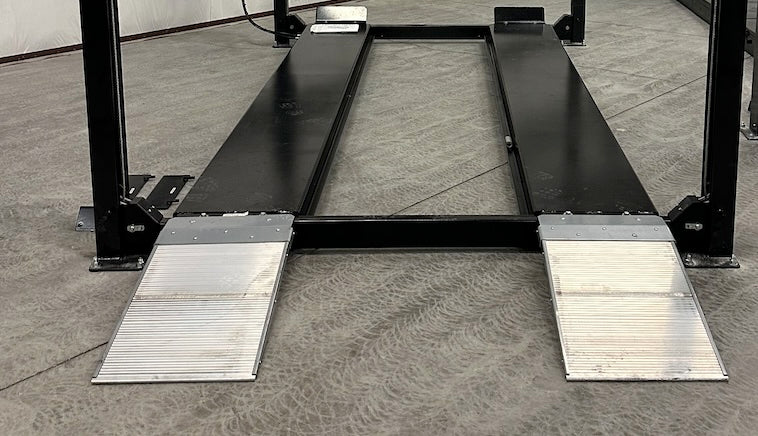Text ( 407) 288- 8353

CAR LIFTS FOR HOME GARAGE
AUTO SHOPS AND GARAGES ALIKE ARE DEDICATED TO PROVIDING THE BEST SERVICES TO THEIR CLIENTS IN AN EFFICIENT AND TIMELY MATTER. DOING SO BEGINS WITH CHOOSING THE RIGHT GARAGE LIFTING EQUIPMENT.
Have you recently opened a garage repair shop and need help deciding on a new piece of lifting equipment? Are you a veteran in the auto industry and ready to expand your shop with new garage lifting equipment? We can help! Below, we discuss our top five lifts and garage lifting equipment that are versatile, durable, and highly effective for your auto shop needs.
BEFORE SELECTING YOUR GARAGE LIFTING EQUIPMENT
While shopping for different garage lifting equipment, there are several things to know and consider prior to purchasing a lift. Below are three important aspects to examine before you choose which model to purchase.
Your Shop’s Ceiling Height
Before buying a lift for your garage, consider the height of your workspace. Does it have low ceilings? To ensure a safe lift installation, your garage’s ceiling height must measure at a minimum of 11 or 12 feet, with clearance for overhead hazards such as lights and fire alarms. The higher the ceiling is, the wider selection of auto lifts you can choose from.
Available Floor Space
Although ceiling height may not be a cause for concern in your garage, assess the remaining floor space available for the installation of a new auto lift. You may purchase the greatest lift for your garage only to find out it is physically impossible to feasibly install it in your cramped floor space.
Have you considered how much space an auto lift needs? It is imperative that you measure as many times as needed for you to guarantee that a lift will not only fit, but also provide the necessary room to adequately service vehicles. If you are unsure about the minimum space requirement for your new auto lift, consider contacting a local and reliable installer.
The Intended Purpose of Your Lift
Consider the most common vehicle types your garage services. Are they pickup trucks, motorcycles, or traditional, compact and SUV cars? Making a wise auto lift purchase depends on assessing and determining your typical load capacity, needed lift height, and desired lift speed.
AUTO LIFTS FOR HOME GARAGE
Once you determine your available ceiling height, floor space, and the intended purpose of your garage lifting equipment, it is time to explore the most reliable, durable, and efficient lifts.
#1. Frame Engaging Lifts
Excellent for use in home garages, low-rise frame engaging lifts – often scissor or parallelogram style – are the most basic model available. These lifts often have a load capacity of under 3 tons.
Electric-hydraulic or compressed air often drive frame engaging lift movement. It is important to note that frame engaging lifts do not provide access to the entire underside of the vehicle. Therefore, low-rise frame engaging lifts are most often employed for wheel work or body projects.
#2. Two-Post Surface Mounted Lifts
Two-post surface mounted lifts are one of the most common types, often utilized in “drive-through” maintenance shops – drive in, fix the car, drive out. Consisting of two columns, these lifts are named for their design. These lifts are built either symmetrically or asymmetrically.
Most mechanic shops will own two-post surface mounted lifts, because surface mounted lifts generally allow for full access to the underside of the vehicle. Full reach under the car makes repairs of any kind easy to access, especially exhaust or fuel system work. Therefore, two-post lifts must be bolted to the floor, eliminating easy mobility. If the lift will remain put, this will not be an issue.
#3. Four-Post Lifts
The four-post lift is commonly considered the most popular and versatile car lift a shop can utilize. Due to extra support, four-posts lifts are extremely sturdy, with greater load capacity than their two-post counterparts.
Four-post runway lifts are wheel-engaging, allowing vehicles to drive directly onto the lift. The lift can adjust to the work being done.
With a four-post lift, you can reach heights of up to 14 feet to work on a vehicle. Their load capacity makes four-post lifts a common solution in the automotive repair industry.
Certain four-post lifts do not require anchorage to the floor, allowing them to be moved with ease when needed. Though common in a professional setting, four-post lifts can also be found in the hands of homeowners and automotive enthusiasts – largely due to their mobility and use as a way to store more cars in small space one right over the other. Furthermore, four-post lifts can double as storage, allowing for two cars stacked in the same location.
#4. Drive-On Parallelogram Lifts
The parallelogram lift resembles both the four-post lift and scissor lift. In functionality, the parallelogram lift is drive-on, like the four-post. Aesthetically, it resembles a scissor lift with accordion-like hoisting mechanisms beneath runways. The parallelogram differentiates itself in mobility; it moves slightly forward or backward while in motion.
#5. In-Ground Lifts
In-ground lifts have been a widespread component of automotive shops for years, an industry standard. Their key characteristic is in the name; these lifts descend into the floor when not in use. In-ground lifts are also popular for flexibility of design. They can either be frame or wheel engaging.
In-ground auto lifts are often equal in cost to other lifts and do require more installation steps and time. However, their unique functionality, low cost of ownership and durability have proved extraordinary in automotive repair shops and home garages for decades.
